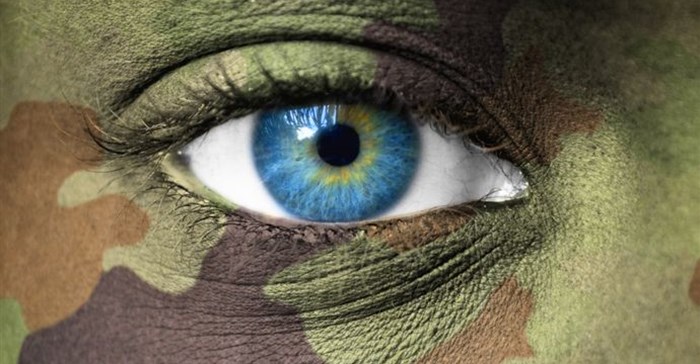
Top stories



So what do marketers do in a world that wants brands to disappear? They learn to vanish!
There is a great difference between obscurity and camouflage, although the undiscerning eye would not know the difference. Obscurity happens when one blends in, to the point when no one notices you. Think wallpaper, hooded teenagers, and asphalt. Camouflage is about blending in for a specific purpose. In the military it is mostly for the purposes of surprise attacks, or to observe from a nearer vantage point. This is closer to the future of brand strategy than we realise.
Tomorrow's brands will be disappearing brands. Let me explain.
Generally speaking, no one wants to hear from brands unless... they're relevant (maybe), or they entertain (this is sometimes true) or unless the consumer chooses to hear from them (now we're getting warmer). It is becoming clearer that consumers want conversations on their terms, not ads.

Using deep consumer insights, brands will live in the consumer's environment. Often without them being conscious of it. Although there always will need to be a time for it, future brands won't sell. They will live within with a tribe. Consumers will become 'friends' with a brand before they begin to buy. Just like social circles, socially attractive brands will win in this new landscape.
The IBM Global CEO Study finding backs this up: 88% of CEOs said "getting closer to customers" was the top priority for their business over the next five years. Brands that have a genuine, real-time dialogue with consumers will be well positioned in a world of evolving and increasingly niche markets. This is brand camouflage.
In nature, some animals mimic others to either flatter or attack. In mimicking, they make themselves look like their target. In human behavioural terms, this is called mirroring. The deeper two people get into conversation, the more they begin to mirror (or mimic) posture and words of the other person. Disappearing brands will understand this and have the ability to mimic customer behaviour to create affinity.
The most important aspect of mimicry is that the other person feels flattered by it. Those who feel flattered will have a higher affinity for brands who do just that. Marketers already know the theory of doing this well: brand tone of voice, visual brand identities, brand activities (clever sponsorships) etc. But marketers need to get smarter in their application to flatter consumers; I am constantly surprised by how well Red Bull does just this, without pushing product into thirsty faces.
Brands that know when to appear in the right place at the right time still get the reception they are looking for. For example, when Castle Milk Stout relaunched to an entirely new audience (urban not rural, young not old), we helped them create a 'Pause in the Sky', targeting individuals wanting to pause in their busy schedule and enjoy the moment. Doing this in places like the Durban July was a perfect surprise attack. The brand spoke to them in the right tone, with a visual identity they felt was their own, and mimicked the lifestyle they longed to be living.
That was four years ago. Today, Castle Milk Stout enjoys some of the fastest growth in the overcrowded beer market in a new, younger more urban audience.
It's not going to be simple, but it will be necessary. These are key takeouts for me:
1. Spend time doing greater segmentation of the tribes you operate in. Use an expert for this, it's worth the investment.
2. Get damn good at speaking like them, remembering that each consumer group will have differing language usage.
3. Get your brand dressed in their clothes. Visually speaking. You'll need a strong core identity that can morph easily into various looks, much like a beautiful woman who pulls off an evening dress as well as she does a bikini to the beach, all the while remaining true to herself.
4. Go undercover. Find ways to be a friend rather than a salesman. Invest into moments of friendship. It may appear costly at first but it will pay dividends later.
5. Carefully and meticulously plan the specific moments when the brand appears in the middle of its new 'friendship circle' and knocks the socks off consumers, creating deeper loyalty and wider buying behaviour in the process.
